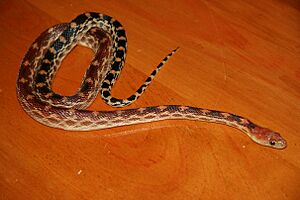Cape gopher snake facts for kids
Quick facts for kids Cape and Baja gopher snake |
|
|---|---|
 |
|
| Conservation status | |
| Scientific classification | |
| Genus: |
Pituophis
|
| Species: |
vertebralis
|
| Synonyms | |
|
|
The Cape gopher snake or Baja gopher snake (Pituophis vertebralis) is a type of snake. It is not venomous and lives only in the southern part of Baja California Sur, Mexico. These snakes are becoming popular as exotic pets. People like them because they have many different colors and are usually calm.
Scientists used to think this snake was a subspecies of another snake, Pituophis catenifer. There is some debate about whether the Baja Gopher Snake is slightly different from the Cape Gopher Snake. Some experts think they should be considered separate types.
Contents
About the Cape Gopher Snake
The Cape gopher snake gets its name from where it lives. This is the Baja California Peninsula in Mexico. You can find these snakes high up in the southern part of the peninsula. The weather there is usually mild, around 78 °F (25.5 °C).
Amazing Colors and Patterns
One cool thing about the Cape gopher snake is its colors. A single snake can have many different colors and patterns. Near its head, it might have bright orange H-shaped marks. These are usually on a bright yellow background.
As you look down the snake's body, the patterns change. They become darker and turn black. The yellow background also becomes less bright. Some Cape gopher snakes start with black stripes. These stripes then change into the usual marks of this snake species. If a snake is coiled up, its different colors might make you think it's several snakes!
Size and Defense
Adult Cape gopher snakes are usually about 36 to 66 inches (91.5–168 cm) long. That's about 3 to 5.5 feet! Baby snakes are born smaller, around 12–18 inches (30–48 cm) long.
When a Cape gopher snake feels threatened, it has a clever trick. It flattens its head and shakes its tail. It also makes a loud hissing sound. This makes it sound and look a lot like a rattlesnake. This helps scare away predators.
Where They Live
Most of what we know about where Cape gopher snakes live comes from stories. But we do know their home is very diverse. It's mostly a desert area. This desert is full of cacti.
However, their habitat also includes other places. There are dry tropical forests and desert shores. They also live in the Sierra de la Laguna mountains. This area is a special reserve recognized by UNESCO. It has important and very different ecosystems.
This region can go months or even years without rain. But it can also get a lot of water very quickly. This happens when a tropical storm or hurricane brings heavy rainfall.
How They Behave
Young Cape gopher snakes can be quite aggressive. They get easily upset. Each snake has its own personality. But young ones often strike at anything that moves.
Luckily, this aggressive behavior doesn't last long. As they get older, they become much calmer. They rarely strike at anything, except for food. However, Cape gopher snakes can still be nervous when people handle them. They might stay still for a bit. Then they become active and squirm around. After a while, they calm down again, and the cycle repeats.
What They Eat
Scientists believe Cape gopher snakes eat small rodents. They also likely eat birds and eggs. We don't know for sure what they eat in the wild. This is because not much research has been done on these snakes in their natural home. When they are kept as pets, small rodents and eggs are enough for them.


